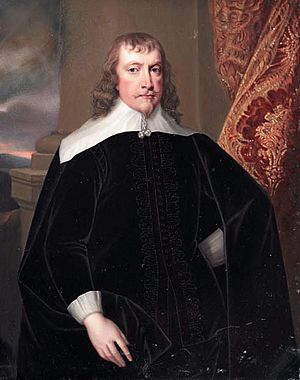Francis Russell, 4th Earl of Bedford facts for kids
Quick facts for kids
The Earl of Bedford
|
|
|---|---|
 |
|
| Born | 1587 |
| Died | 9 May 1641 (aged 53–54) |
| Spouse(s) | Catherine Brydges |
| Children | 8, including: William Russell, 1st Duke of Bedford Colonel John Russell |
| Parent(s) | William Russell, 1st Baron Russell of Thornhaugh Elizabeth Long |
Francis Russell, 4th Earl of Bedford (1587 – 9 May 1641) was an important English nobleman and politician. He is best known for building the famous Covent Garden area in London. This included the piazza and the church of St. Paul's. He worked with the famous architect Inigo Jones on this project.
He also started a big project to drain the wet lands called The Fens in Cambridgeshire. This helped turn marshy areas into useful farmland.
Contents
Early Life and Rise to Power
Francis Russell was the only son of William Russell, 1st Baron Russell of Thornhaugh. His mother was Elizabeth Long. He became Baron Russell of Thornhaugh in August 1613.
Before that, he was a Member of Parliament (MP) for Lyme Regis. In 1623, he became Lord Lieutenant of Devon. This was a royal representative in the county. On May 3, 1627, he became the Earl of Bedford. This happened after his cousin, Edward Russell, 3rd Earl of Bedford, passed away.
A Voice in Parliament
Francis Russell was a strong voice in English politics. In 1621, he joined other nobles. They complained to King James I about too many new titles being given out. They felt this made their own titles less special.
Later, in 1628, he supported the House of Commons. This was during debates about the Petition of Right. This petition aimed to limit the king's power. Russell was on a committee that said the king could not imprison people without good reason.
He was briefly arrested in 1629. This was because of a misunderstanding about a political paper. But he was quickly released when the truth came out.
Leading the Parliamentarians
By April 1640, the Earl of Bedford was a main opponent of King Charles I. He was highly trusted by other important leaders like John Pym. Clarendon, a historian, called him a "great contriver" in the House of Lords.
In September 1640, he was among the nobles who asked King Charles to call a new parliament. They also wanted peace with the Scots. He helped negotiate the Treaty of Ripon.
When the Long Parliament began in November 1640, Bedford was seen as the leader of the parliamentarians. In February 1641, he became a privy councillor. He was even promised the job of Lord Treasurer. This was a very important financial role.
Bedford was a moderate person. He wanted to solve problems peacefully. He tried to find a good way to manage the king's money. He also got along well with Archbishop Laud. Even though he believed Strafford was guilty of treason, he wanted to save his life.
Sadly, Francis Russell died of smallpox on May 9, 1641. His death happened in the middle of these big political struggles.
Developing Estates and Lands
Around 1631, the Earl of Bedford worked with architect Inigo Jones. Together, they built the famous Covent Garden square in London. This project included a large open space called a piazza and the church of St. Paul's.
Bedford also led a huge project to drain The Fens in Cambridgeshire. These were large areas of marshy land. This project was so important that the drained area was named the "Bedford Level" after him. He and others involved were supposed to get 95,000 acres of land. This was their payment for the hard work.
He spent a lot of money, about £100,000, on this project. He received 43,000 acres of land. But the project faced many challenges. In 1638, the king took over the work. The draining project was finally finished in March 1653, years after Bedford's death.
The 4th Earl of Bedford is buried in the 'Bedford Chapel'. This chapel is located at St. Michael's Church in Chenies.
Family Life
Francis Russell married Catherine Brydges (who passed away in 1657). She was the daughter of Giles Brydges, 3rd Baron Chandos. They had eight children together:
- William Russell, 1st Duke of Bedford (August 1616 – 7 September 1700).
- Francis Russell (died around April 1641).
- Colonel John Russell.
- Edward Russell (died 21 September 1665). He was the father of Edward Russell, 1st Earl of Orford.
- Catherine Russell (died 1 December 1676). She married Robert Greville, 2nd Baron Brooke.
- Margaret Russell (died 1676). She married James Hay, 2nd Earl of Carlisle first. Then she married Edward Montagu, 2nd Earl of Manchester.
- Anne Russell (died 26 January 1697). She married George Digby, 2nd Earl of Bristol.
- Diana Russell (died 30 January 1695). She married Francis Newport, 1st Earl of Bradford.

